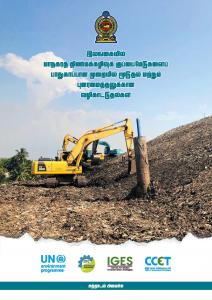Municipal Solid Waste (MSW) management, particularly final disposal as open dumps has become a global issue. Worldwide, dumpsites are the third largest anthropogenic source of methane, accounting for 11 percent of estimated global methane emissions or 881 million tonnes of CO2 equivalent. The 50 largest dumpsites affect the daily lives of 64 million people, 17 million of whom live in Asia, and all dumpsites affect all 17 SDGs either directly or indirectly. Similarly, dumpsites have become a serious issue in Sri Lanka, which experienced the catastrophic collapse of one in Meethotamulla in 2017, causing 32 fatalities and the destruction of 87 houses. The lack of proper final disposal techniques has been the major bottleneck faced by many local authorities. A common grievance voiced by many local authorities is that insufficient land resources, technical support, and finances hinder the transition from open disposal to sanitary landfilling. However, it has been well recognized that open dumping practice can no longer be allowed to continue, and appropriate waste resources recovery and disposal strategies should be established at any cost. Thus, a simple guideline for dumpsite closure and rehabilitation is of paramount importance for local authorities which would help reduce pollution risks on the environment and public health at the local level and climate and SDG achievements at the global level.
The term “dumpsite rehabilitation” in these guidelines refers to any work, including partial work carried out on a MSW dumpsite aimed at improving existing conditions to minimize the hazard risk caused by leachate contamination, gaseous emissions, waste burning, collapse due to instability, and all other associated socio-economic issues. Accordingly, these dumpsite rehabilitation guidelines aim to provide for or advise on: a) a risk assessment procedure to determine the level of pollution caused by a dump and its rehabilitation potential; b) implementable rehabilitation and closure plans; c) appropriate technical intervention to minimize leachate contamination, uncontrolled gaseous emissions, waste burning, and risk of dumpsite collapse; and d) an appropriate operation and maintenance procedure that ensures the sustainability of technical improvement measures.
Chapter 1 emphasizes the need for rehabilitating existing open disposal sites to improve the health and environmental setting in the country and explains the scope and organization of the guideline.
Chapter 2 discusses the distinction in the definition of the term dumpsite and landfill and introduces the engineered approach to landfilling.
Chapter 3 elaborates on the dumpsite risk assessment procedure, based on the Source-Pathway-Receptor (S-P-R) conceptual model. It presents a sequential approach to risk assessment: the development of a conceptual site model identifying pollution sources, pollution migration pathways, and receptors of pollutants. The risk screening process introduced describes quantitative and qualitative assessment based on a risk screening process that can be executed by experts and trainers to develop a conclusion on the level of risk posed by the dumpsite.
Chapter 4 is a brief guide to the planning requirements needed to fulfill the objectives of dumpsite rehabilitation, as well as general planning requirements.
Chapter 5 elaborates on the technical planning requirements for a typical dumpsite rehabilitation project and discusses the aspects of technical requirements, potential areas for improvements, types of studies to be conducted, and potential sources of information and technical services.
Chapter 6 presents a simple decision-making process based on risk assessment and planning objectives. The process involves the use of the guidelines to choose the appropriate level of dumpsite rehabilitation from five different levels of improvement based on the risk level assessed in chapter 2. The legal and regulatory requirements to be followed during the rehabilitation process are also covered.
Chapter 7 describes the different levels of dumpsite closure and development and offers a guide to choosing the appropriate closure level based on regulatory requirements, technical feasibility, and level of risks.
Chapter 8 describes the operation and maintenance requirements to be followed to achieve the objectives set forth during the planning process. It covers the maintenance of landfill cover systems, stormwater drain systems, leachate collection and treatment systems, and landfill gas management systems.
Chapter 9 briefly describes the project development, design, construction, operation, and monitoring process of two rehabilitated dumpsites in Sri Lanka namely Moon Plains and Galapitayaya, Kataragama in Sri Lanka, and two dumpsite rehabilitation projects in India.

